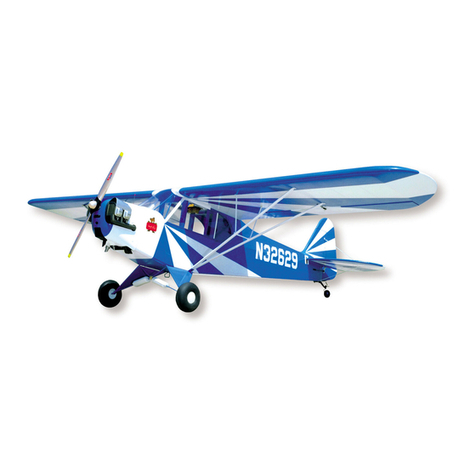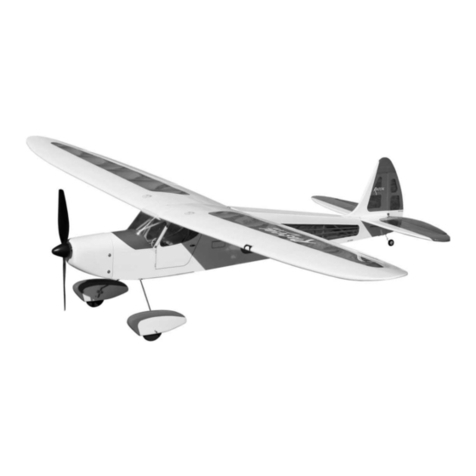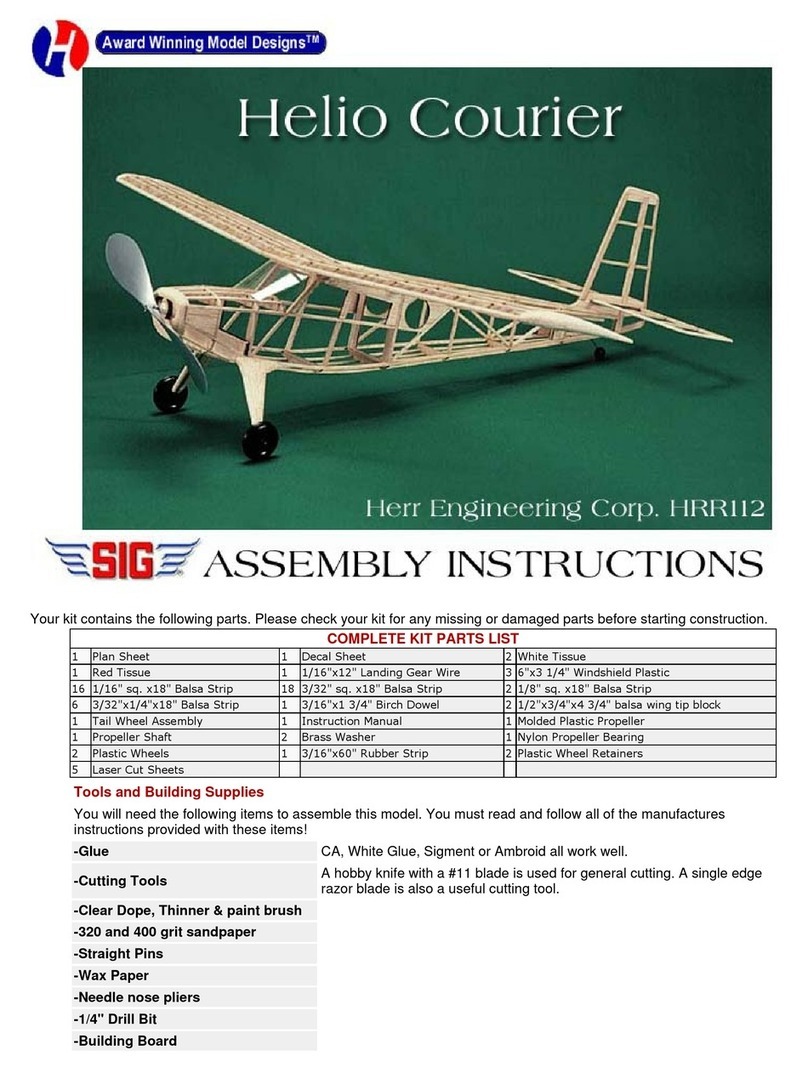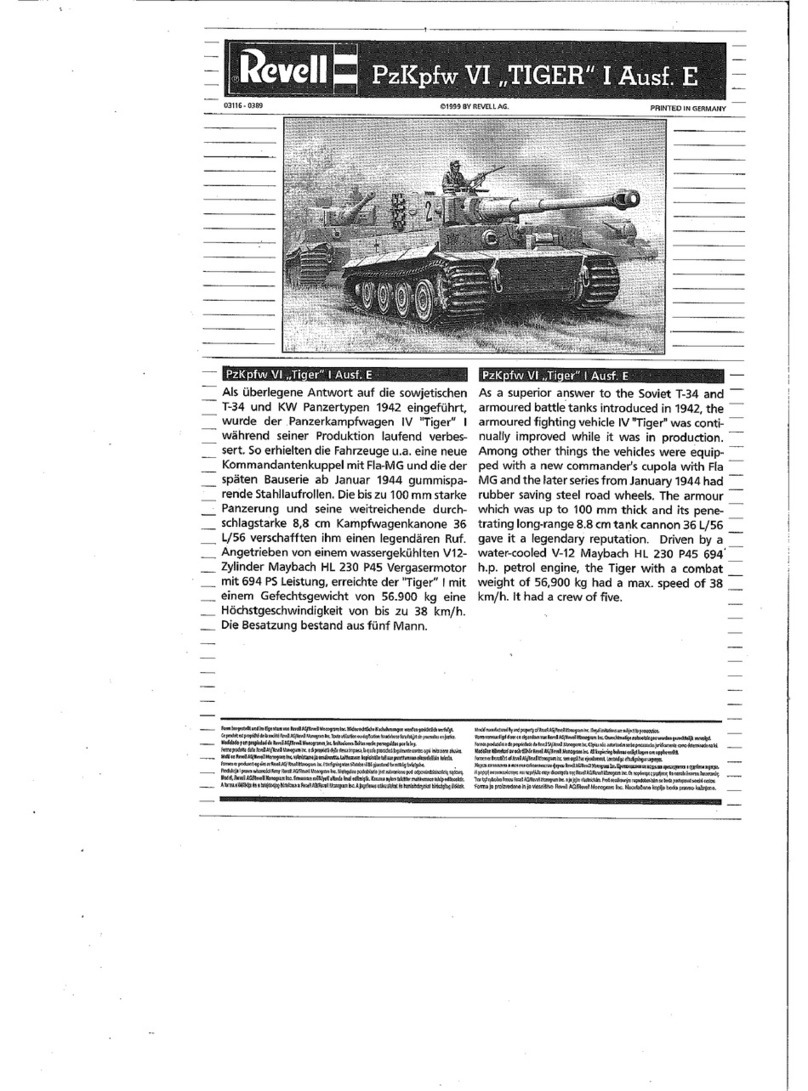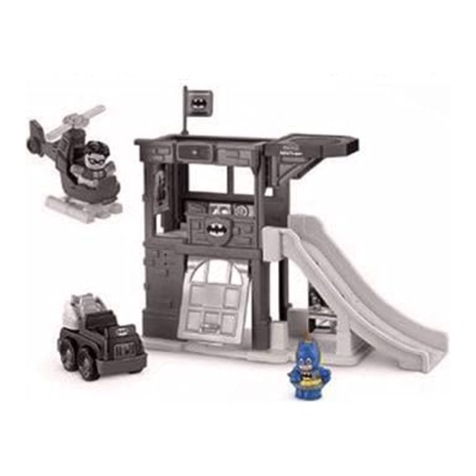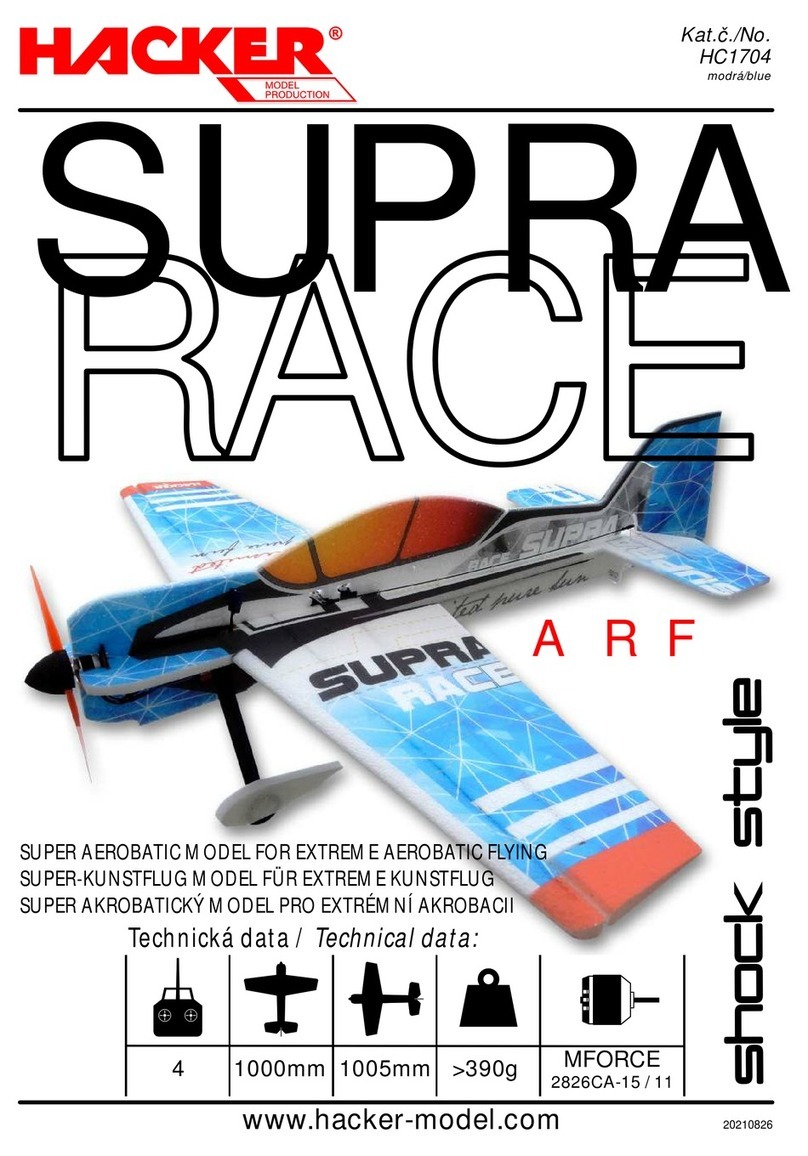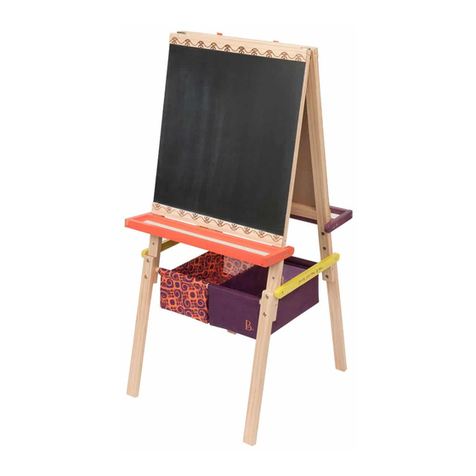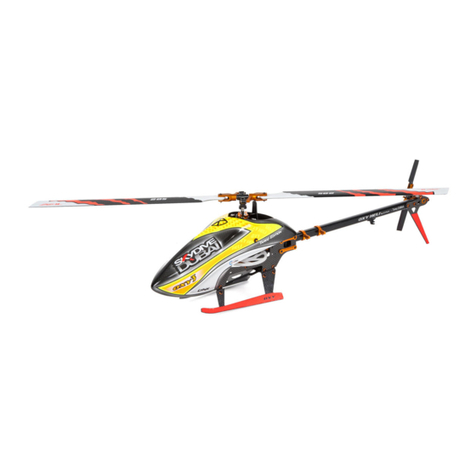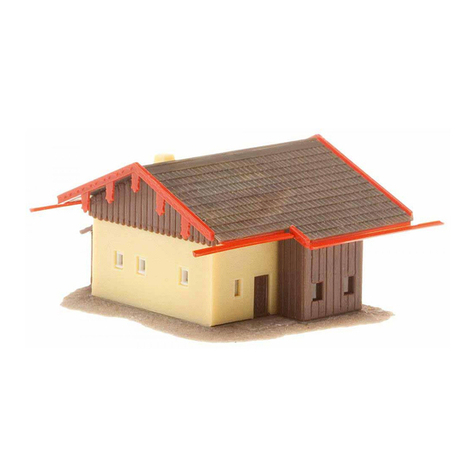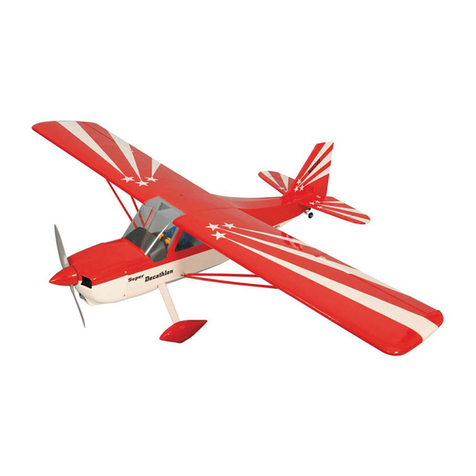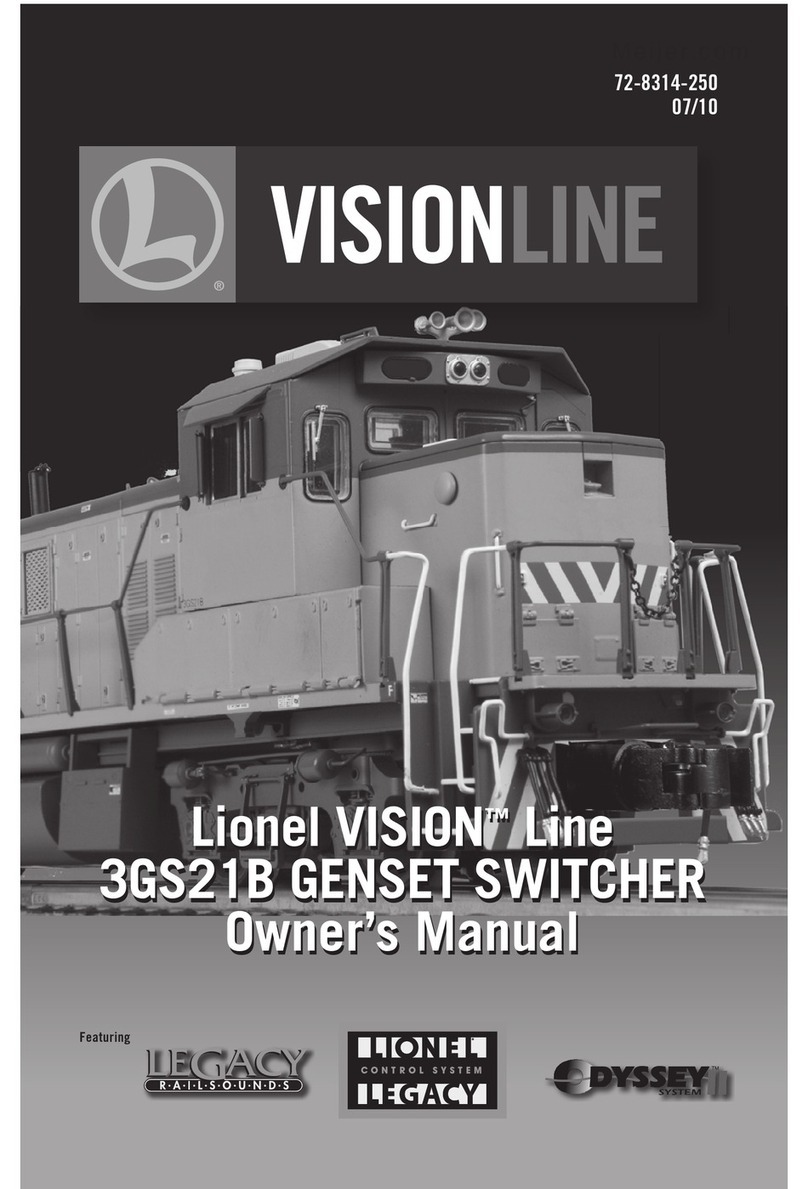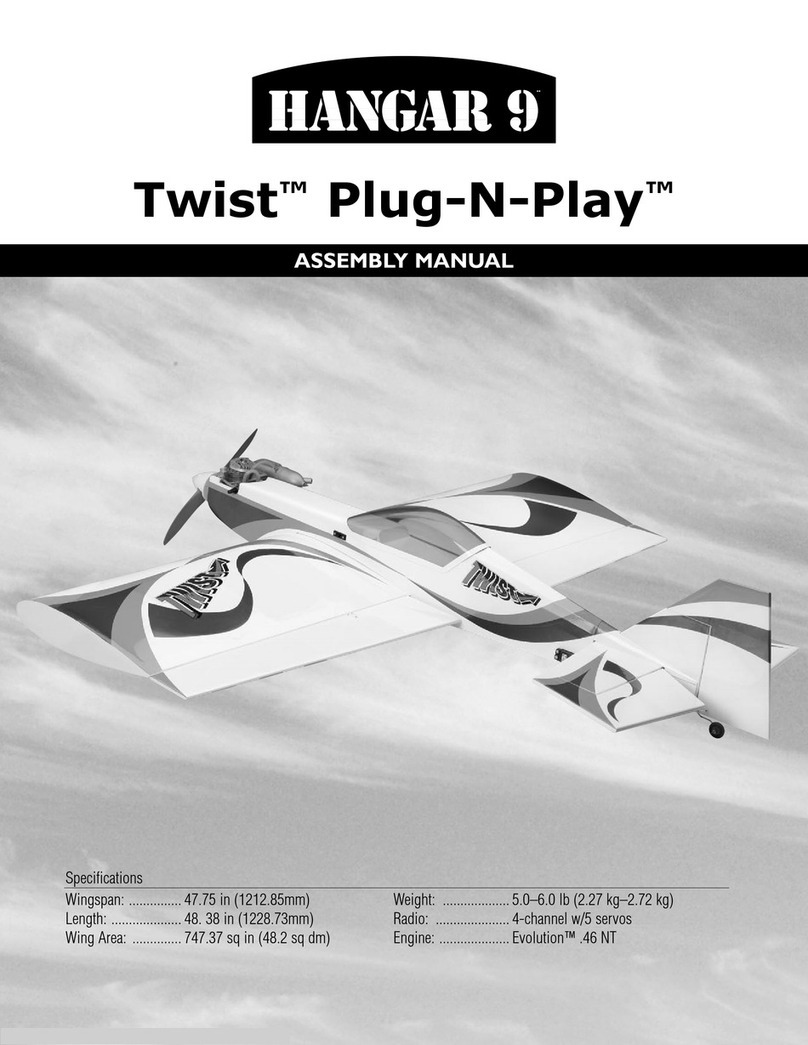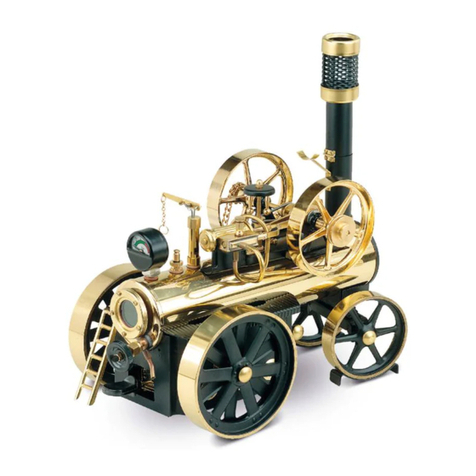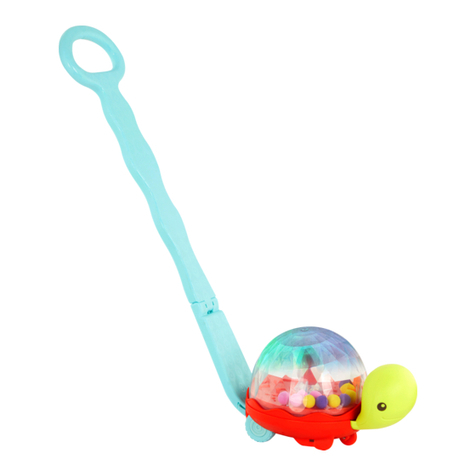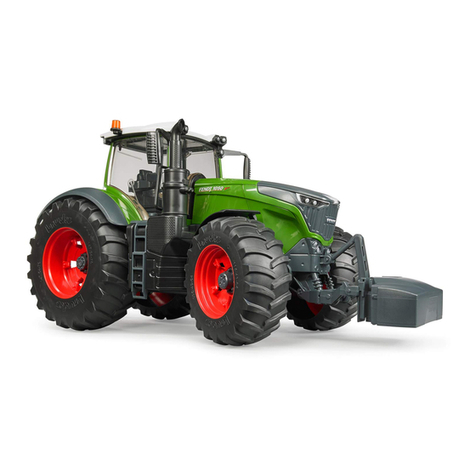SIG SIGRC95ARF Fokker D.VII User manual


Assembly Instructions
Easily the most feared German fighter aircraft of World War One ...
The Fokker D.VII was hurriedly developed in late 1917 and began flying over the front lines in late March of 1918. The airplane very
quickly earned favor with its pilots because of its outstanding speed, climb and maneuverability characteristics. In addition, it was also
well armed with two forward firing 7.92mm Spandau machine guns and 500 rounds of ammunition. Early D.VII aircraft were
powered with 6-cylinder 160-hp D.III Mercedes Benz engines. A later variant, the D.VIIF, used the more powerful 185-hp B.M.W.
D.IIIa engine. This engine increased the airplane’s performance even further, placing the D.VIIF in high demand from all German
fighter groups. Fortunately for the allies, these engines could not be built fast enough, and the war ended before the B.M.W. powered
D.VIIF could be delivered in mass quantities.
The Fokker D.VII was so feared by the allies, that when the armistice treaty that ended World War I was signed in November 1918, the
Fokker D.VII was the only aircraft specifically mentioned in Aricle IV as a weapon that must be entirely destroyed or confiscated.
The SIG Fokker D.VII represents the aircraft flown by Lt. August von Raben, Commanding Officer of Jasta 18 from March to
November 1918. This fighter group was called the "Raben" (Raven) squadron and all of their fighter aircraft, including the Fokker
D.VII fighters, were painted in the distinctive red and white color scheme depicted on your model.
Your SIG Fokker D.VII is a very nice replica of this famous WWI fighter aircraft. It flies very nicely with fighter-like
maneuverability and flight characteristics. It is a true "parkflyer" type model that can be flown in smaller areas. The airframe is
lightweight and tough and should provide you with many enjoyable missions. To get the most out of your Fokker D.VII, take your
time and follow the assembly instructions carefully.
SIG FOKKER D.VII SPECIFICATIONS:
Wing Span: 32-3/4” (83.2 cm)
Wing Area: 273 sq.in. (1761 sq.cm.)
Power System: 180 Class with 4.4:1 Gear Box
Propeller: E.M.I. 8.5” x 8” Propeller (215.9 x 203mm)
Battery: 6-cell 720 mAh NiMH Square Pack, or
7-cell 300 mAh NiMH "Folded" Pack
Flying Weight: 11 oz. (w/ 6-cell 720 mAh pack)
10.3 oz. (w/ 7-cell 300 mAh pack)
Wing Loading: 5.8 oz./sq. ft. (w/ 6-cell 720 mAh pack)
5.4 oz./sq. ft. (w/ 7-cell 300 mAh pack)
Radio Requirements:
(1) 3 or more channel transmitter on “Aircraft” Frequency
(1) Micro Receiver
(2) Micro Servos
(1) 5amp Electronic Speed Control (ESC)
2
Lineup of Fokker D.VIIs belonging to Jasta 18. Note first airplane has
fuselage painted red all the way back to the stabilizer, while the
second airplane has red to back of cockpit, like the Sig Fokker D.VII.

3
Bag #1: SIGRPFU295
1 . . .Fokker Left Fuselage Side
1 . . .Fokker Right Fuselage Side
Bag #5: SIGRPWB295
1 . . .Fokker Wood Parts Die-Cut Sheet
Bag #6: SIGRPPROP293
2 . . .E.M.I. 8.5 x 8" Propeller
Bag #7: SIGRPMGDU293
1 . . .SIG 180 Class Power System
3 . . #3 x 10mm Phillips-Head Screws
Bag #8: SIGRPWC295
1 . . .Fokker Molded Plastic Wheel Covers
2 . . .50mm Dia. Molded Plastic Main Wheels
4 . . .Metal Wheel Retainer Washers
Bag #4: SIGRPTF295
1 . . .Fokker Horizontal Stabilizer and Elevators
1 . . .Fokker Vertical Fin and Rudder
Kit Contents: Do a complete inventory of your kit before starting assembly.
Bag #2: SIGRPWK295
1 . . .Fokker Top Wing
1 . . .Fokker Bottom Wing
1 . . .Fokker L/G Spreader Wing
2 . . .Wing Reinforcing Strips (1-1/4” x 20-1/4”)
Bag #3:
1 . . .Fokker Molded Plastic Hatch Cover SIGRPCC295
1 . . .Fokker Molded Plastic Cowl SIGRPCW295

4
Bag #9: SIGRPHP293
4 . . .Wing Attach Rubber Bands (#32)
2 . . .#2 x 8mm Phillips-Head Screws (cowl attach)
1 . . .Velcro®Strip (cockpit cover attach)
2 . . .Molded Plastic Control Horn
2 . . .Molded Plastic Control Horn Retainer
2 . . .Molded Plastic Control Horn Clevis
2 . . .Molded Plastic Control Horn Clevis Retainer
2 . . .4mm OD x 75mm Aluminum Wing Tubes
Loose Packed in Box:
1 . . .Fokker Decal Sheet SIGDKM295
2 . . .Fokker Wire Pushrods With "Z" Bend at One End
1 . . .Fokker Wire Main Landing Gear SIGRPBM295
1 . . .Fokker Instruction Manual (not shown)
Additional Items Needed To Complete This Model
Tools and Supplies:
-Small Phillips Screwdriver -Hobby Knife With #11 Blade -Needle Nose Pliers -Small Side Cutting Pliers -Scissors
-Sig Thin C/A Glue -1/16” Drill Bit -Small 90OSquare -1” Paint Brush -12” Ruler
-Sig 5-Minute Epoxy -3/4” wide Scotch®Tape -220 Grit Sandpaper -Rubbing Alcohol -Straight Pins
-Sig 30-Minute Epoxy -#32 Rubber Bands or Low Tack Drafting Tape -3/4” wide Filament Packing Tape
-Soft Foam Rubber
Radio Equipment:
Airborne Radio Components...
A good, reliable radio system is essential to the enjoyment and safe operation of your Fokker D.VII.
We use and highly recommend Hitec radio equipment for this model. We show the installation of Hitec HS-55 micro servos in this
manual. These servos are both extremely small and powerful for their size. We use dual conversion receivers for our models because
they allow us to fly our airplanes with other modelers without fear of 3rd order interference, a common problem with single
conversion receivers. There are several very good dual conversion micro receivers on the market, such as the Hitec Electron 6 and the
FMA M5. If you decide to use the Hitec Electron 6 receiver, you can easily remove the plastic case, as we did, saving even more weight.
Of course, there are a number of other small receivers and servos on the market that can be substituted with equally good results. Select
components that have specifications similar to the HiTEC equipment listed. Watch the weight of components carefully as using
heavier than recommended equipment will have a very detrimental effect on the flight performance of your Sig Fokker D.VII.
Electronic Speed Control (ESC)... We show the installation and use of a MAXX Products MX-9105 ESC in this manual. Other ESC
units may be used, provided they have a minimum rating of 5 amps.
Flight Battery Pack:
The flight battery supplies power to both the radio system and the motor. We have had good success with two different battery packs:
a) 6-Cell 720 mAh NiMH (Nickel Metal Hydride) rechargeable pack, in the "square" configuration.
b) 7-Cell 300 mAh NiMH (Nickel Metal Hydride) rechargeable pack, in the "folded" configuration.
Both of these battery pack types will fly your Fokker D.VII well. The difference is that the 6-cell 720mah pack will fly the airplane a
little slower but with longer flight times - up to 13 minutes with throttle management. The smaller and lighter 7-cell 300maH pack will
fly your Fokker D.VII with greater power but for less flight time - about 6-7 minutes with throttle management.
MAXX Products MX-9105 Electronic Speed Control 6-Cell 720 mAh NiMh Battery Pack (square) 7-Cell 300 mAh NiMh Battery Pack (folded)

Battery Charger:
The charger for the flight battery pack is one of the most critical pieces of equipment for flying electric powered airplanes. Having the
correct charger and using it properly can make the difference between an electric airplane that flies well and one that can’t even get
off the ground. Failure to select the appropriate charger, or using it improperly, will cause performance related problems and
unsatisfactory results. By far, the majority of performance related problems we see with electric powered models are almost always
traced directly to an improperly or incompletely charged flight battery pack.
To correctly charge the recommended battery packs you MUST have a charger that is capable of performing “peak detection” charging
of NiMH (Nickel Metal Hydride) batteries. We use the ASTRO FLIGHT 115D charger, a top-of-the-line AC/DC peak detection
charger. This unit is capable of fast-charging or slow-charging either Nicad or NiMH battery packs at selected rates and is very versatile
in its operation. Obviously other brands of chargers can also be used, as long as they have capabilities similar to the Astro Flight 115D
unit -- i.e. most importantly, “peak detection” charging of NiMH batteries. An old R/C car battery charger WILL NOT work!
Before Beginning Assembly
Take your time and follow the assembly instructions carefully. The foam parts of your Fokker D.VII can be dented easily so be
gentle. To help protect your model during assembly, cover your work bench with an old towel or a sheet of foam rubber. Use only the
glues specified or you will damage the parts. Specifically, DO NOT use C/A Glue on any of the foam parts or they will be damaged.
5
Twist tube to bevel
Slight bevel on inside
Fuselage
Straight Fuselage
Bent
Fuselage side (cross section)
Apply epoxy sparingly to inside
edge of one fuselage side
as shown.
GOOD BAD
Assembly Starts Here:
1...Use a small piece of 220 grit sandpaper to remove any
burrs from the ends of the two 4mm x 3-11/16” Aluminum
Wing Tubes. Now use your hobby knife to slightly
bevel/sharpen the inside of one end of one tube as shown.
2...Prepare the fuselage halves for assembly by using the
sharpened end of the aluminum tube to open up the four
required wing dowel holes in the fuselage sides. Lay the
fuselage half on a firm surface and gently press the tube into
the hole with a twisting motion to finish cutting through the
fuselage sides. Next, use your hobby knife to open up the
pushrod exit holes in the rear of each fuselage half. Last,
lightly sand the mating surfaces of both fuselage halves to
remove any molding flash from the foam.
3...Carefully apply 30 minute epoxy to one of the fuselage
sides as shown. Since the epoxy is many times stronger than
the foam, you only need to use a small amount to bond the
fuselage sides together. By applying the epoxy in this manner
you will eliminate having a lot of epoxy squeezing out on the
outside of the model. We recommend using #32 rubber bands
to hold the fuselage sides together until the epoxy cures. Use
care to make sure that the fuselage is straight and not bent or
twisted. NOTE: You can also use low-tack drafting tape to
hold the fuselage sides together if preferred. However, use
caution because tape can pull the paint off the model if the
adhesive is too tacky. Use tape only on areas of the model that
will not be seen after it is completely assembled.
Remove burrs from ends
Rubber Bands Tape

6
Servo Tray
Firewall &
Cowl Mounts
Wing Tubes
Tail Skid
4...Use 5-minute epoxy to glue the
plywood Firewall, the 2 Cowl Mounts,
the Servo Tray, the Tailskid, and the 2
Aluminum Wing Tubes in place in the
fuselage.
NOTE: Be sure the firewall is firmly
seated into the recess molded into the
front of the fuselage. This recess has
been molded to provide the correct right
and down-thrust for the motor.
Glue the servo tray in place with the
grain running across the fuselage.
The wing tubes should be centered, so
that an equal amount sticks out on each
side of the fuselage.
5...Use 3/4" wide 3M Scotch®Crystal Clear Tape to hinge
the tail surfaces. Apply a strip of tape to the top of the
Horizontal Stabilizer, centered over the hinge line. Turn the
stabilizer/elevator assembly over and apply another strip of
tape, again centered over the hinge line. Repeat this process
with the Vertical Fin/Rudder assembly.
NOTE: 3/4” wide tape is available at most office supply
stores. Use only clear tranparent tape. Do not use frosted
Scotch®Magic Tape.
6...Use a sharp hobby knife to trim and remove the
unwanted foam bridges from the Stabilizer/Elevator
assembly and the Fin/Rudder assembly. There are 5 bridges
to remove:
A. Trim 2 foam bridges connecting Stabilizer to Elevator.
B. Trim foam bridge connecting top of Rudder to Fin.
C. Trim foam bridge connecting bottom of Rudder to Tab.
D. Trim foam bridge connecting bottom of Fin to Tab.
7...Use a small diameter dowel with a smooth rounded end,
similar object, to indent the tape on each side of the tail
surface until the two pieces of tape contact each other in the
middle of the hinge gap, creating the finished hinge.
8...Now is the best time to apply all the decals to the various model parts, before the parts are glued together and become more
cumbersome to handle. Use the box label and the assembly manual pictures for proper positioning of the decals.
DECAL APPLICATION NOTES: The decals provided in this kit are a type of water transfer decal that you may not have used
before. They are extremely thin and light, and when they are on the model they look like they’re painted on. Notice that the decals
are printed on the paper carrier upside down. There is a thin clear plastic sheet over the decals that protects a low tack adhesive.

9...Use your hobby knife to open the control
horn slots in both the rudder and elevators.
Insert the rudder control horn through the
slot so that the arm sticks out on the left side
of the rudder. Insert the elevator control
horn from the top so that the arm sticks
down from the bottom of the right elevator.
Now slide the retainer plates onto the horns
with their locating pins facing the foam.
Firmly press the clip in place until you hear
or feel two "clicks", indicating that the clip
is securely locked in place.
7
GOOD
BAD
BAD
90O
GOOD
To apply the decals, leave the clear plastic in
position while you cut the individual mark-
ing from the main sheet. When ready to
apply the decal, remove the clear plastic and
place the decal in the desired location, adhe-
sive side down. Make sure you get the decal
exactly where you want it. The light tack
adhesive allows the decal to be picked up
and repositioned if necessary. With the
decal in the proper position, use a brush or a
12...Plug the airborne electronics together and test for proper function. The two servos are plugged into channel 1 (normally
aileron) and channel 2 (normally elevator) on the receiver. The electronic speed control plugs into channel 3 on the receiver. When
doing this, make very sure that you have installed the three plugs with the correct polarity! Then plug the motor, without the
propeller, into the “motor" side of the ESC. Make sure your transmitter and airborne battery pack are fully charged.
soft rag to generously apply cold tap water to the paper. The paper will immediately begin to soak up the water. Let the paper com-
pletely soak for at least 1-2 minutes. Now gently SLIDE paper from the top of the decal. DO NOT try to move the decal on the
model's surface. The decal is very thin and fragile. If the decal has air bubbles under it, use a soft cloth to gently pat out the bub-
ble, making sure you pat straight up and down, not sideways. DO NOT try to push the bubbles sideways from beneath the decal.
While these decals are more fragile than normal decals, the end result is a marking that looks as if it were painted on. Allow the
decals to completely dry for at least an hour or two before handling.
10... Temporarily attach the lower wing to the fuselage with
two rubber bands. Use 5-minute epoxy to glue the
stabilizer and elevator assembly in place on the fuselage.
The stabilizer should be roughly parallel to the wing and
should not be tilting to the left or right. The slot in the
stabilizer should be centered with glue seam in the fuselage
and must remain free of glue. Use straight pins to hold the
stabilizer in position until the epoxy sets. After the glue
dries, the bottom wing can be removed.
11...Use 5-minute epoxy to glue the fin and rudder
assembly in place. The bottom of the fin must be glued on
top of the stabilizer, while you simultaneously glue
the "tab" at the bottom front of the rudder into the
corresponding slot at the rear of the fuselage. Make sure
the fin and rudder are 90O to the horizontal and does not tilt
to the left or right. Use straight pins to hold the fin in place
until the epoxy sets.

8
13...Install the rudder and elevator servos into the plywood
servo tray in the fuselage. Viewing the model from the rear,
the rudder servo is mounted on the right side and the elevator
servo is mounted on the left side. The servo output arms
should be at the rear end of the servo body, as shown.
14...Install the Wire Pushrod for the rudder into the fuselage.
Start by inserting the “Z” bend end of the wire into the left
pushrod exit hole at the rear of the fuselage (again viewing
the fuselage from the rear). Run the pushrod all the way up
to the rudder servo, which is on the right side of the fuselage.
Remove the control arm from the rudder servo, slip it onto the
“Z” bend, and then reinstall the control arm back onto the
servo. Be sure to tighten the servo arm screw.
Install the elevator pushrod in the same manner. Insert it into
the right exit hole at the rear of the fuselage, and run it
forward to the elevator servo on the left side of the fuselage.
Install the elevator servo control arm to the “Z” bend.
15...Slide a plastic Control Horn Clevis Retainer onto the
rudder pushrod wire. Snap a plastic Control Horn Clevis into
the rudder horn, with its open side facing outward, as shown.
Hold the rudder in neutral while you lay the threaded end of
the pushrod wire into the groove in the plastic clevis. Push
the wire down firmly into the groove.
16...Slide the Clevis Retainer onto the Clevis, trapping the
pushrod wire in place. Check to be sure that the rudder is still
in the neutral position. If it is not, unsnap the clevis from the
control horn and adjust the pushrod length by screwing the
clevis in or out on the threads. Then repeat this process to
attach the elevator pushrod to the elevator control horn.
Clevis
To operate the system, first turn on the
transmitter and place the throttle stick in the
full low position. Now plug the airborne
battery pack into the "battery" side of the ESC.
The system should now be operational (see
NOTE below). Test the system by moving the
right stick on the transmitter, which should
move the rudder and elevator servos.
Typically, with most ESCs, the motor is not
"armed" and will not function when you first
turn on the power, for safety reasons. To arm
the motor, the throttle stick must be moved
all the way up and all the way back, one or
possibly two times. Be sure to read the
instructions that came with your particular ESC
to learn the manufacturer's arming method.
Once the ESC is armed, the motor should function and react to movements of the throttle stick. Make sure everything is
functioning properly on your workbench BEFORE you install any of the components into the model. While the radio system is
still on, make sure the rudder and elevator trim levers on the transmitter are centered in neutral position. This ensures that the
servos are centered. Unplug the battery from the ESC to turn the airborne system off and then turn off the transmitter.
NOTE: Some radio manufacturers provide a small micro-size Switch Harness. We suggest that you not use the switch harness to
save weight. It is very easy to turn the airborne system on and off by simply plugging in and unplugging the battery pack.
Clevis
Retainer
Elevator Servo
Rudder Servo
Notice that elevator & rudder pushrods
cross each other in rear of fuselage.
Push
Motor
Battery
ESC
Receiver
Elevator Servo
Rudder Servo

9
17...Plug the two servos and the ESC back into the correct
receptacles in the receiver. Place the receiver on the bottom
of the fuselage, in front of the servos. Cut a piece of soft
foam rubber (not furnished) to fit over the receiver and hold
the receiver in place. Install the ESC on top of the foam
rubber. Poke the ESC’s motor plug through the hole in the
front of the fuselage and into the motor compartment. Make
sure the ESC’s battery plug will be accessible at the top of
the battery compartment.
Turn on your transmitter and then plug the battery pack into
the ESC. Stow the battery pack in the radio compartment,
right up against the back of the foam firewall. Cut another
piece of soft foam rubber to put between the battery pack
and the front of the servos, to keep the battery from moving
around. Check the radio for proper operation. If the servos
move in the wrong direction, use the servo reversing on your
transmitter to change the direction of travel.
Adjust the control throws to the following measurements:
Rudder: 3/4” Right 3/4” Left
Elevator: 1/2” Up 1/2” Down
18...Drill a 1/16" dia. hole in the bottom of the fuselage, just
behind the rear wing dowel, as shown. Feed the receiver
antenna through this hole. Pull the antenna back to the rear
of the fuselage and hold it in place with a small piece of
Scotch®Tape just behind the tailskid. Allow the full length
of the antenna to trail behind the model. Do not cut the
antenna to shorten it. That will reduce the radio range.
19...Remove the cabane struts from the die-cut plywood
sheet. Note that there are two inner cabane struts and two
outer cabane struts.
a. Use 5-minute epoxy to glue the two inner cabane struts
into the appropriate pockets molded into the fuselage sides.
Note that the pockets are pre-molded at the correct angles.
Hold the struts in place until the glue dries.
b. Use 5-minute epoxy to glue the two outer cabane struts
into the appropriate pockets in the fuselage sides. Let dry.
c. Glue the tops of each set of inner and outer cabane
struts together, being careful to match up the top edges of
the struts to create a smooth wing saddle.
Tape
Antenna Exit Hole Receiver Is Under Foam
ESC
Inner Cabane Struts Outer Cabane Struts

22..Apply the Wing Reinforcing Tape (14mm X 43mm) to the
leading edge of both the top and bottom wing. The tape should be
centered on the leading edge left and right and should be applied
so that it wraps around the leading edge with half on the top of the
wing and half on the bottom of the wing.
Apply the two star decals to the top of the top wing and allow to
dry.
Remove the two plywood wing struts from the die cut sheet. Insert
the struts through the bottom wing. Use 5 minute epoxy to attach
the struts to the bottom wing. The struts should be aligned vertical.
Now glue the top stubs into the top wing with 5 minute epoxy. Align the wings square and allow the epoxy to dry.
22..Use 5 minute epoxy to glue the two die cut plywood landing gear inserts into position on the landing gear. The short one goes at
the front of the landing gear and the taller one is at the rear.
Trim the two Molded Plastic Wheel Covers as shown. Use a 1/16”
drill bit to drill a hole for the axle in the center of each cover.
Press one Wheel Retainer on each axle and slide all of the way in.
Now place the wheel, wheel cover and outer Wheel Retainer into
position. The outer wheel retainer should spaced so that the wheel
turns freely.
23..Attach the wing on the model using 4 rubber bands. Now install the landing gear by pressing the front and rear upper ends com-
pletely into the slots in the fuselage. Attach the number decals to the fuselage sides between the wing and the tail surfaces.
24...Plug the speed control into the receiver. Charge and connect the airborne battery and test the radio and power system WITH-
OUT THE PROPELLER ATTACHED.
Make sure that all of the controls and the throttle function properly.
When everything checks out, securely attach the propeller onto the power system.
25...Place the battery in the model and install the Plastic Cockpit Cover. Check the balance of the model. To do this, turn the model
upside down and support the model on your finger tips placed 1/2” back from the leading edge of the bottom wing. Hold your fin-
gers close to the
10
20...Trim the plastic Hatch Cover as shown. Test fit the
trimmed Hatch Cover onto the top of the fuselage and adjust as
needed for a good fit. Note:A sharp hobby knife and miniature
snips are very good tools for this job.
Seperate the two parts of the Velcro®strip provided.
Remove the paper backing from one part of the Velcro®, and
adhere that piece of Velcro®to the top of the fuselage.
Remove the paper backing from the other half of the Velcro®
and adhere it to the underside of the Hatch Cover, making sure
it lines up with the Velcro®on top of the fuselage.
21...Pre-drill the three motor mount holes in the plywood
firewall with a 1/16" dia. drill bit. Use the three #3 x 10mm
Phillips-Head Sheet Metal Screws to attach the motor to the
front of the model. Feed the motor connector through the hole
in the front of the fuselage and connect it to the electronic
speed controller.
22...Trim and install the molded plastic Cowl as follows:
a. Use a sharp hobby knife or a small pair of snips to trim
3/16” off the base of the cowl as shown.
b. Sand the trimmed rear edge of the cowl against a piece of
fine grit sandpaper to make the rear edge truly flat.
c. Carefully cut out the three openings in the front of the
cowl as shown. A sharp hobby knife and sandpaper are good
tools for this job.
d. Fit the cowl onto the front of the fuselage to check the fit.
Make any required adjustments. The cowl is mounted to the
fuselage using two #2 x 8mm Phillips Head Sheet Metal
Screws. Hold the cowl in position on the fuselage while you
drill 1/32” dia. pilot holes through the cowl and into the
plywood cowl mounts on each side of the nose. Then mount
the cowl to the fuselage with the two screws.
Velcro®Velcro®
Step 22a
Step 22b
Step 22c Step 22d
3/16”Cutoff

11
23...Apply the Wing Reinforcing Strips (1-1/4” x 20-1/4”) onto
the leading edges of both the top and bottom wings. The strips
should be centered left-to-right on the leading edge, and should
be applied so that it wraps around the leading edge, with half its
width on top and half its width on the bottom of the wing.
24...Remove the two plywood wing struts from the die-cut
sheet. Smooth the edges of the struts with sandpaper. Use
5-minute epoxy to glue the struts in place on the bottom wing.
Make sure the struts are perpendicular (90O) to the top of the
wing surface and allow the glue to dry.
Now glue the top wing in place on top of the plywood struts
with 5-minute epoxy. Align the wings square and hold in
position until the epoxy to dries.
25...Reinforce the wings to withstand high +G aerobatic
maneuvers by running a strip of 3/4" wide filament packing
tape (such as Scotch®#893) spanwise on the bottom of both
wings. Cut a strip of filament tape to fit between the outer wing
strut locations and lay it in place on the bottom of each wing, at
the high point of the airfoil. Press the tape firmly in place.
Remove
flange
Wing Reinforcing Strip
26...Use 5-minute epoxy to glue the two die-cut plywood landing gear inserts into
position on the Wire Main Landing Gear. Use small strips of tape to hold them in
place while the glue dries.
Trim the flange off of the two Molded Plastic Wheel Covers as shown. Use a 1/16”
dia. drill bit to drill a hole for the axle in the center of each wheel cover.
Press one Wheel Retainer Washer onto each axle, and slide it all of the way in as far
as possible. Now slide on the wheel and then the plastic wheel cover. Finally, install
the outer Wheel Retainer Washer. Make sure the wheels turn freely.
Use clear Scotch®tape to fasten the foam L.G. Spreader Wing in place on top of the
wire gear between the landing gear legs.
Tape
Plywood
Inserts
Filament Tape

12
27...Attach the wings to the fuselage using 4 rubber bands - 2
for the top wing and 2 for the bottom wing. Begin by sliding
the wing set over the tail surfaces and into position. Secure
the bottom wing first, being careful to line-up the slot in the
bottom wing with the corresponding slot in the fuselage as
you put on the 2 rubber bands. Then install the landing gear,
pressing the front and rear upper ends of the gear completely
into the slots in the bottom of the fuselage. Last, rubber band
the top wing to the cabane struts.
28...Install the propeller on the motor shaft. The proper order
of installation on the shaft is; first the rear shaft nut, then the
propeller, then the shaft washer, and then the front shaft nut.
When properly installed, the prop shaft should have just a
little bit (1/16” - 1/8") of fore and aft "play". Finally, slip the
rubber Prop Shaft Protector over the prop shaft and nut, up
against propeller. The model is now ready to balance.
29...BALANCING YOUR FOKKER IS IMPORTANT!
Place the flight battery in the model (do not plug it into the
ESC at this time) and attach the plastic hatch cover. Check
the balance of the model by turning it upside down and
supporting it on your finger tips placed 1/2” back from the
leading edge of the bottom wing. Hold your fingers close to
the fuselage sides. Supported this way your model should
hang perfectly level. If the model hangs tail low, you must
move the receiver and battery forward in the fuselage, or if
they are already as far forward as possible, add weight to the
nose of the model until it hangs level. If the model hangs nose
low, you must move the receiver and battery towards the rear,
or add weight to the tail of the model until it hangs level.
30...Always pre-flight your model thoroughly before each flight. It is your responsibility to verify that your model is airworthy.
Always follow established safety guidelines while installing the battery, operating the motor, radio, and while flying the model.
FLYING YOUR FOKKER
Test fly your Fokker D.VII on a day when there is no wind. This allows you to better evaluate and trim the model correctly. The
Fokker is a small, light model and should not be flown on breezy days. Because the Fokker is a small model with small wheels,
it is normally not practical to take off from a typical grass field. While the Fokker will take off from the ground nicely, it needs
a smooth surface to do so. If the grass at your flying area is too long, then you will probably need to hand launch the airplane.
This is done by holding the model level, running the motor up to high throttle, and then tossing the model straight ahead at flight
speed. NEVER throw the airplane in a nose up attitude or tilted to one side or the other. Throw it perfectly level! If you’ve never
hand launched an R/C model before, make your first hand launches over tall (knee high) grass. The grass will protect your model
from damage in the event of a bad launch. Fly the model to a safe altitude before trimming it out.
GOOD LUCK AND SAFE FLYING!
WARNING! THIS IS NOT A TOY!
Flying machines are not toys! Because of the speeds that airplanes must achieve in order
to fly, they are capable of causing bodily harm and property damage if they crash. IT
IS YOUR RESPONSIBILITY AND YOURS ALONE to assemble this model airplane
correctly according to the instructions, to ground test the finished model before each flight
to make sure it is completely airworthy, and to always fly your model in a safe location and
in a safe manner. JOIN THE AMA
The governing body for R/C model airplanes in the United States is the ACADEMY OF
MODEL AERONAUTICS. The AMA provides guidelines for the safe operation of R/C
model airplanes. While AMA membership is not mandatory, it is required by most R/C
flying clubs in the U.S.and provides you with important liability insurance in case your R/C
model should ever cause property damage or personal injury to someone else.
For more information contact: ACADEMY OF MODEL AERONAUTICS
5161 East Memorial Drive; Muncie, IN 47302
Telephone: (765) 287-1256
AMA WEB SITE: modelaircraft.org
CUSTOMER SERVICE
Should you encounter any problem building this kit, or discover any missing or
damaged parts, please feel free to contact us by mail or telephone.
SIG MANUFACTURING COMPANY, INC.
P.O. Box 520
Montezuma, IA 50171-0520
SIG MODELER’S ORDERLINE: 1-800-247-5008 (to order parts)
SIG MODELER’S HOTLINE: 1-641-623-0215 (for tech support)
SIG WEB SITE: www.sigmfg.com
LIMIT OF LIABILITY
The craftsmanship, attention to detail, and actions of the builder/flyer of this model airplane
kit will ultimately determine the airworthiness, flight performance, and safety of the finished
model. SIG MFG. CO.’s obligation shall be to replace those parts of the kit proven to be
defective or missing. The user shall determine the suitability of the product for his or her
intended use and shall assume all risk and liability in connection therewith.
KIT CONTENTS SUBJECT TO CHANGE WITHOUT NOTICE.
Do not attempt to fly your Fokker
until it is properly balanced!
Balance 1/2” back from leading edge of bottom wing.
Rubber
Prop Shaft
Protector
Table of contents
Other SIG Toy manuals
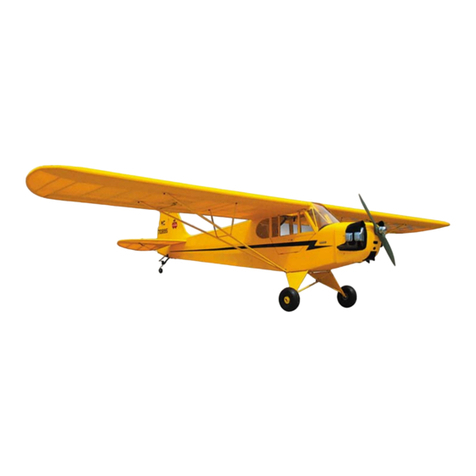
SIG
SIG Piper J3 Cub Instruction Manual

SIG
SIG T-Clips EP ARF User manual
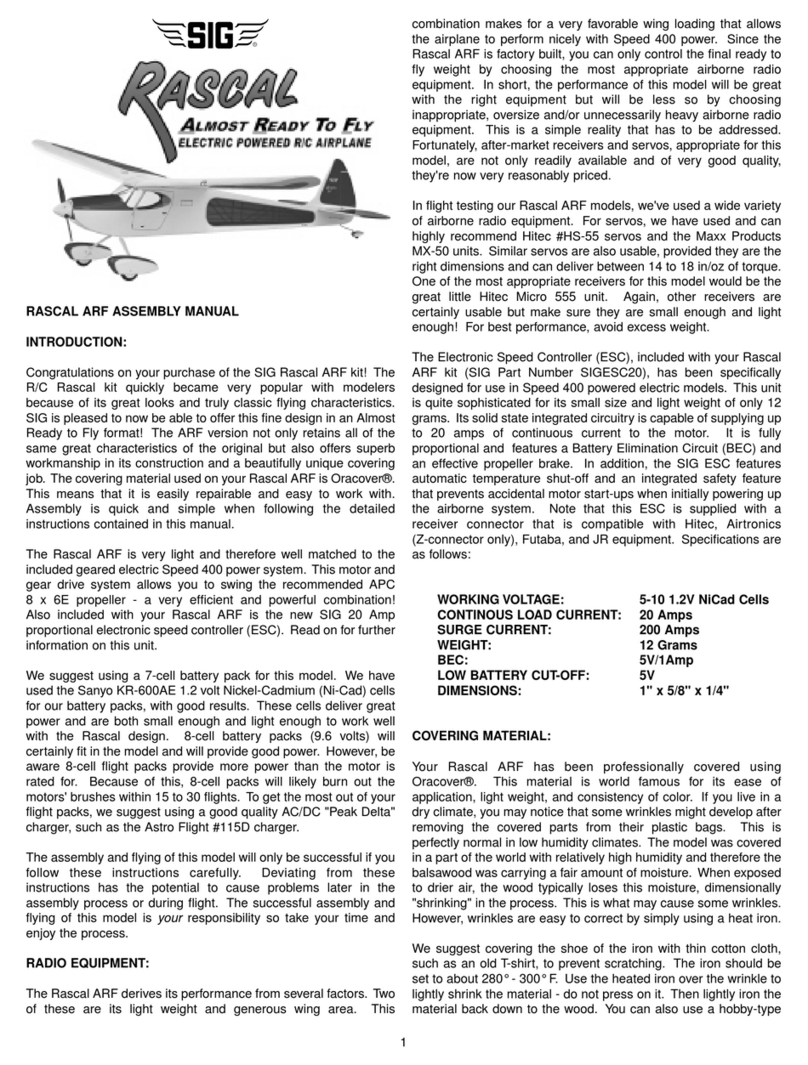
SIG
SIG RASCAL ARF User manual
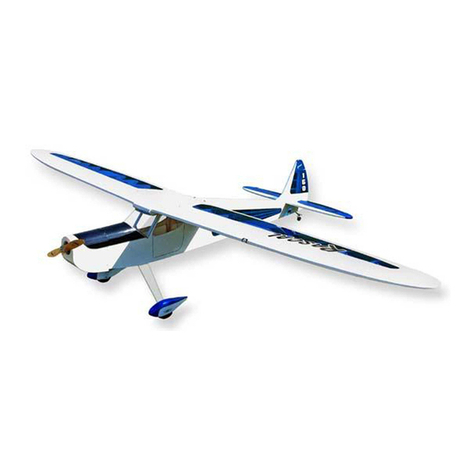
SIG
SIG LIL' RASCAL User manual
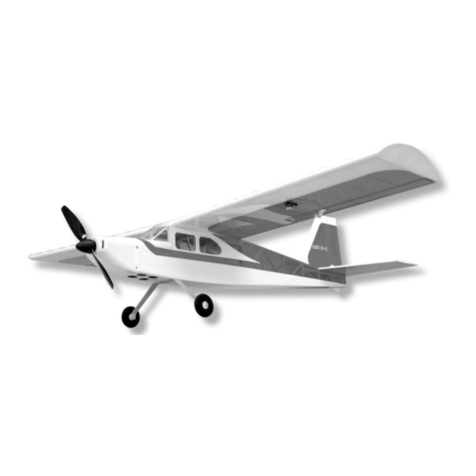
SIG
SIG KADET EP-42B User manual

SIG
SIG KADET LT-25 User manual
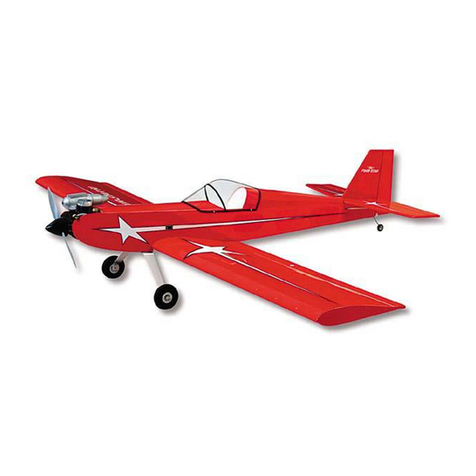
SIG
SIG 4-STAR 60 Instruction Manual

SIG
SIG Piper J3 Cub User manual
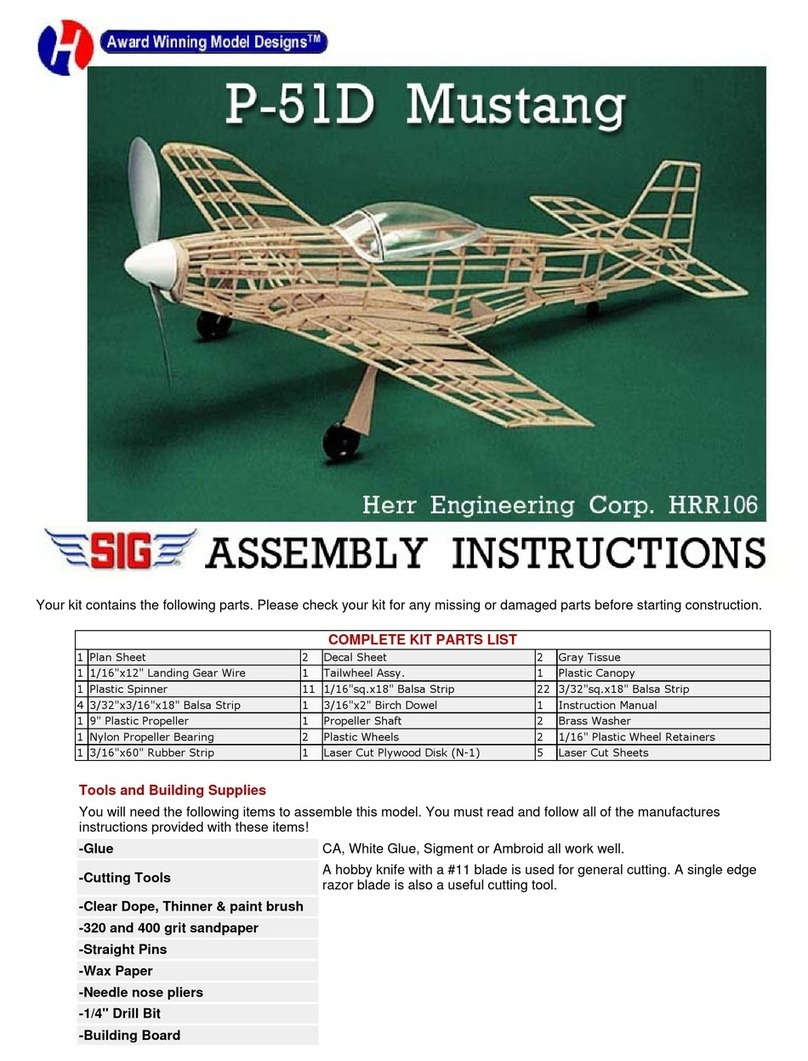
SIG
SIG Award Winning Model Designs P-51D Mustang User manual
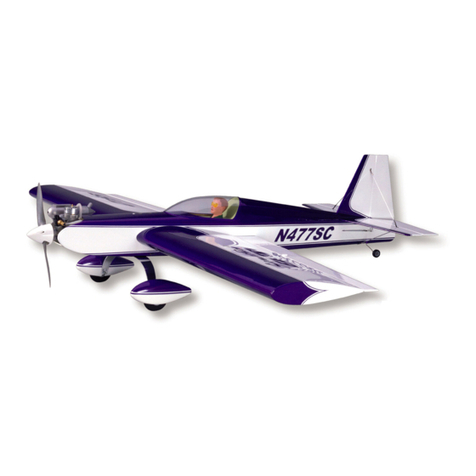
SIG
SIG Somethin' EXTRA N477SC User manual
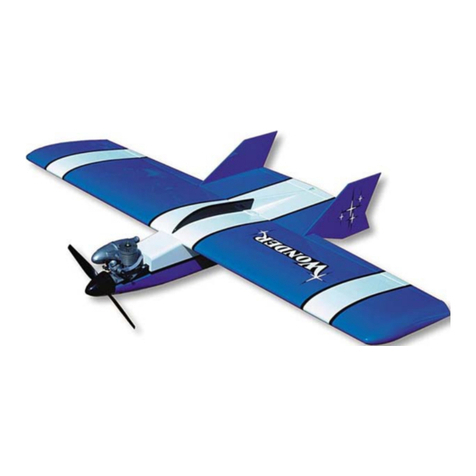
SIG
SIG Wonder Instruction Manual
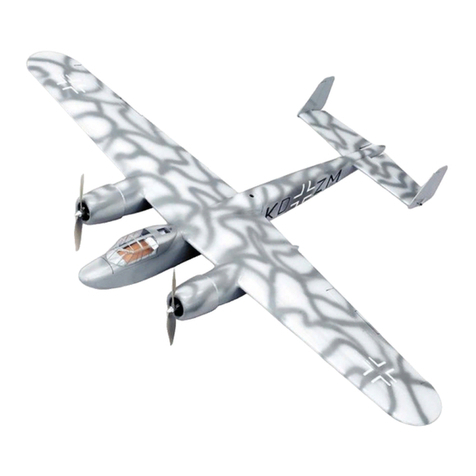
SIG
SIG DORN IER Do 217 User manual
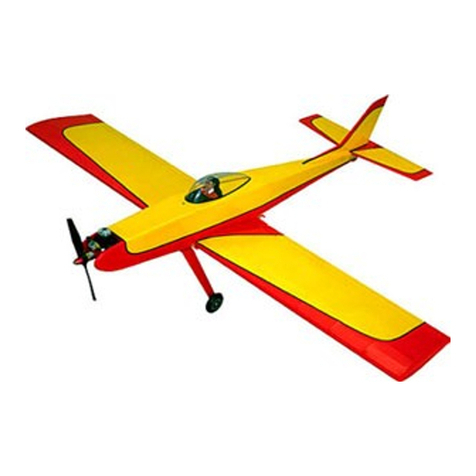
SIG
SIG HUMMER RC-50 Instruction Manual
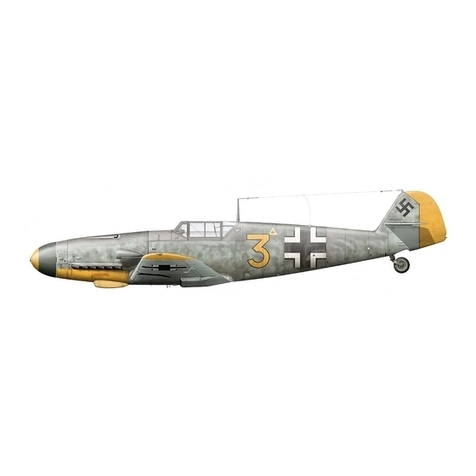
SIG
SIG MESSERSCHMITT Bf-109 User manual

SIG
SIG King Kobra Instruction Manual

SIG
SIG KADET EP-42 User manual
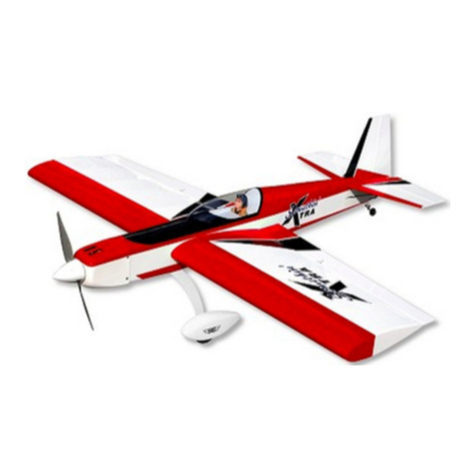
SIG
SIG SIGRC76EGARFG User manual
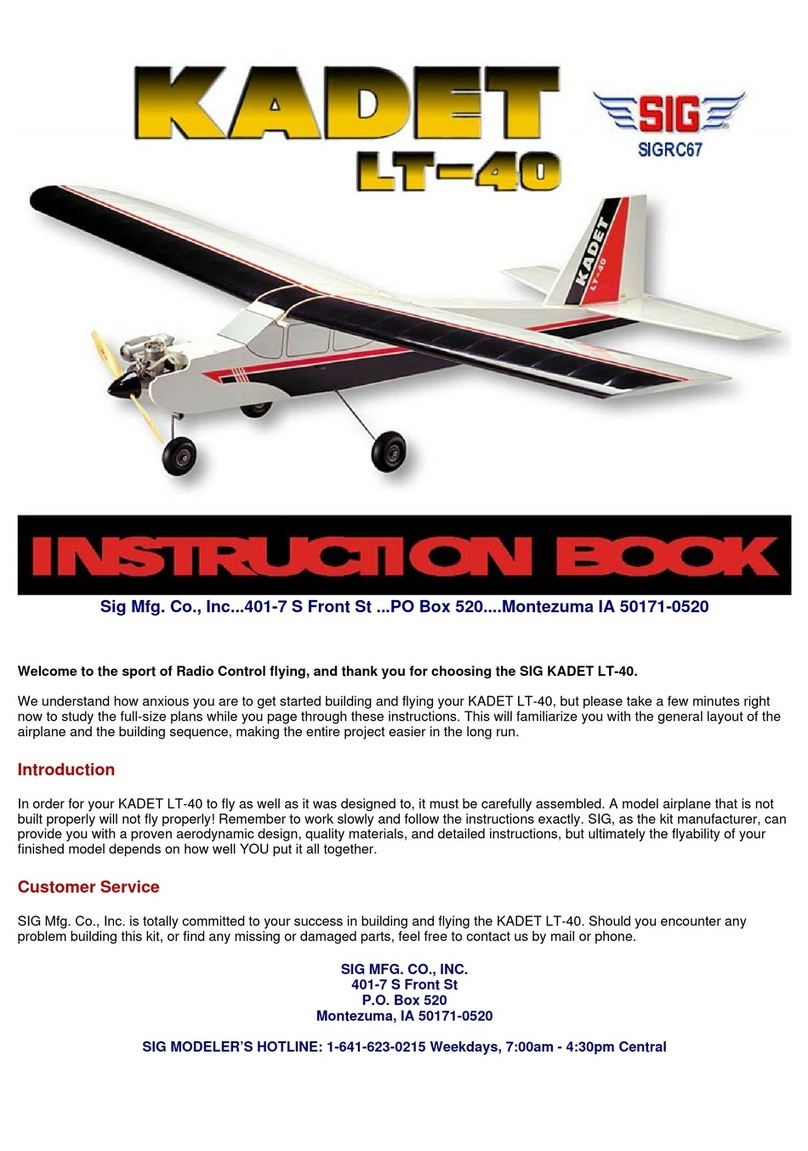
SIG
SIG SIGRC44 User manual
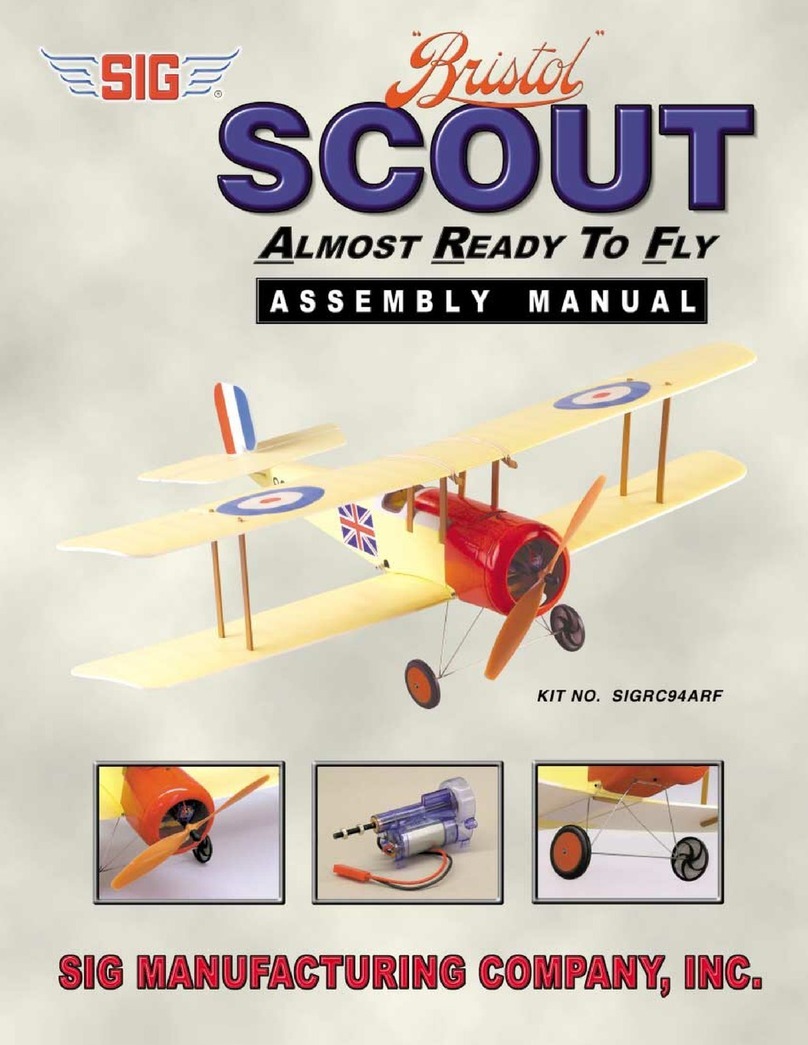
SIG
SIG Bristol Scout User manual
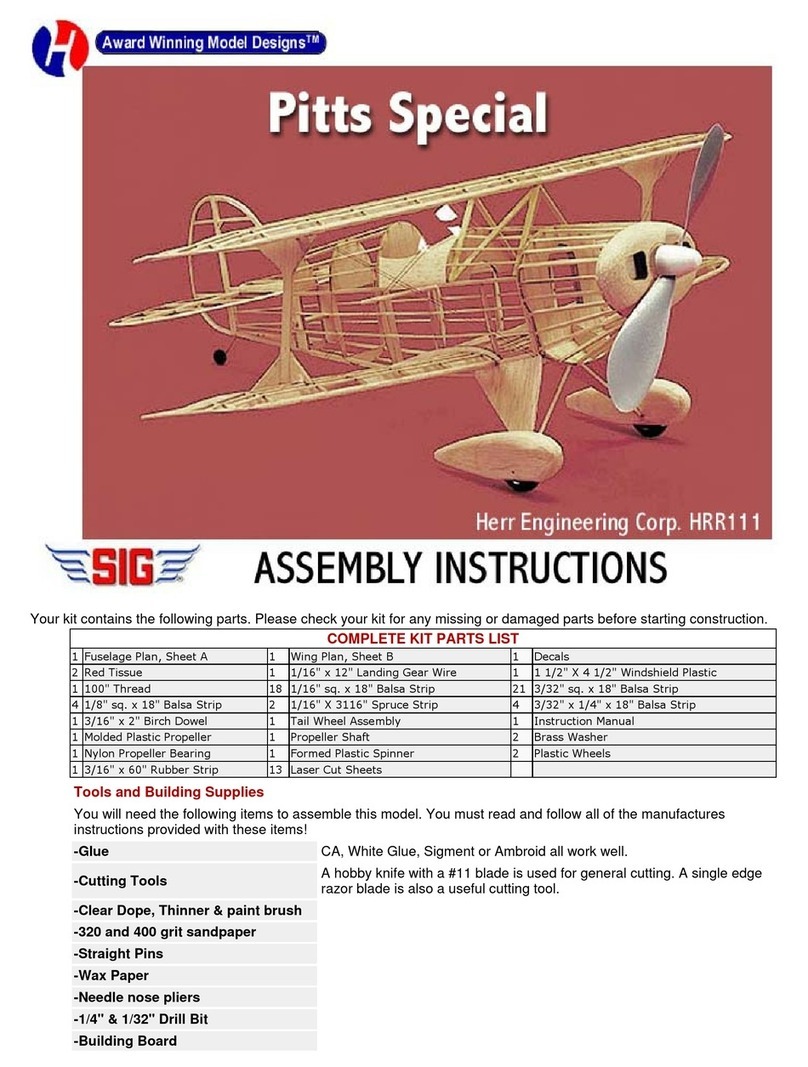
SIG
SIG HRR111 User manual
